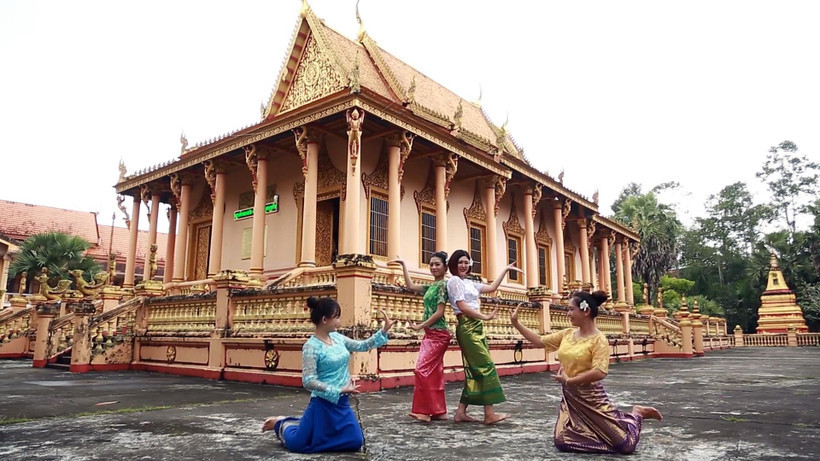Among the Khmer people, there is a saying: “Khmer children can sing and dance before they learn to read or write.”
To them, music and dance are sacred bridges between the human and the divine. Of all their traditional dances, rom vong - also known as lam thon - stands out as a joyful expression of community spirit, woven deeply into religious rites and ceremonial life, including offerings to deities, processions, and peace-seeking rituals.

During traditional Khmer festivals in Soc Trang, rom vong becomes a vibrant, communal celebration. It can take place anywhere - from homes to temple courtyards to rice fields - and welcomes participants of all ages and backgrounds.
As the drums beat and melodic voices rise, individuals and pairs join the circular dance, moving gracefully in soft, fluid motions.
The name rom vong itself means “circle dance,” and dancers often turn toward each other with affectionate glances and smiles, forming a collective rhythm of harmony and connection.
The movements of rom vong are elegant and deliberate. Women perform with subtle, flowing arm gestures near the chest, while men use broader, stronger movements, extending their arms as if to shield and support their partners.
The coordination between arms and legs is key: if one leg is forward, the matching arm remains lower; palms alternate between facing up and down in balance.
Each movement in rom vong has symbolic meaning. The chip gesture, representing sprouting buds, expresses hope and vitality - performed by joining the thumb and index finger while the other fingers stretch back. The khuon movement, symbolizing blossoming fruit, involves curving the middle finger toward the thumb to form a circle. Other movements include ron (to shield), chon-ol (pointing), tho-thuol (welcoming and receiving), vong, and sek (the gait of a parrot), each with distinct cultural depth.
There is also etiquette to follow: younger or lower-ranking individuals dance first and later invite elders and guests to join.
The more circles the dancers complete, the more joyous the celebration becomes. Khmer dancers often join hands and rhythms with guests from the Kinh or Hoa communities, blending cultural lines through shared movement. When the drums stop, dancers pause, press their palms together in greeting, and return to their places.
Rom vong has become a vital expression of Khmer identity, leaving an enduring mark on daily life and memory.
The dance fosters warm connections and romantic beginnings - many couples have found love through exchanged glances and smiles in the rhythm of the dance. In recognition of its cultural value, rom vong was officially included in Vietnam’s list of national intangible cultural heritage in 2019.
PV